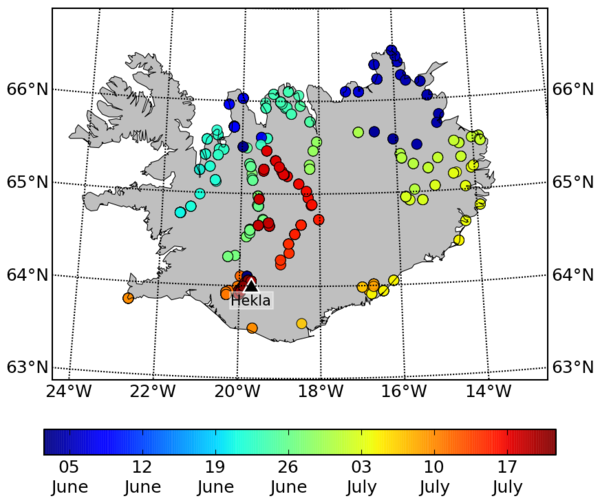This is a quick post to let you know how the fieldwork is going so far.
Sampling the distal deposits of Hekla’s largest eruptions since the ice age
The aim of my project is to sample the deposits of the two largest explosive eruptions from Mt Hekla since the end of the ice age. The tephra (pumice + ash) from these eruptions is found all over Iceland, as well as across mainland Europe. The measurements made this summer will be combined with analysis of the samples to give us a much better idea of what these eruptions were like (e.g. how high the plume reached, how much very fine ash was produced). Then we can work out the likely results if it happens again.
Because the ash is all over Iceland, I have had to go all over Iceland, as the map shows.

The map was created using the information stored in 'geotagged' photos. The colour of the dots tells when the photo was taken, and the map shows everywhere that I have been in the first 7 weeks. Click to enlarge.
The first two months were very successful, as Iceland has had record-breakingly good weather. I’ve had a number of babysitters who have come and looked after me along the way, including Al Monteith, who blogged about his time here. His blog has lots more detail and photos of what we have been up to: http://alasdairmonteith.blogspot.com/2012/07/iceland-round-up.html
Iceland by converted ambulance
My home for my time in Iceland is a Volkswagen T4 Synchro van. It used to be an ambulance, and still has medicine cabinets, a bracket for hanging a saline drip, and the switch to turn on the siren (which has disappointingly been disconnected). The daily routine of wake, eat, drive, dig, drive, dig, eat, drive, dig, drive, dig, cup of tea, drive, dig, eat, computer, whisky, sleep is a very efficient way of covering the ground. Additional buy food, buy petrol, hot tub! mixes things up a bit.
As well as being fairly large and very comfortable, the van is also very capable, as the video beneath shows.
Pumice, pumice, pumice
The aim of the first part of the summer was to check that the ash covers as much of Iceland as was previously thought (it does), and to collect lots of samples of it (248 so far). I had a few days at home this week, where I had my only 3 nights sleep under a roof since late May, and a few days in Reykjavik sorting out repairs and supplies. Now we are all set to head back out to the field tonight.
This time the aim is to sample material closer to the volcano. This is where most of the material fell, including thick deposits of pumice. It’s hard work digging the holes to find the bottom when there is so much material, but if you ask nicely, sometimes you can get a helping hand.


Pingback: Volcano suit / What to wear in Iceland | Volcan01010